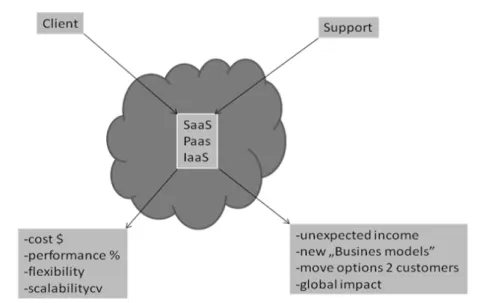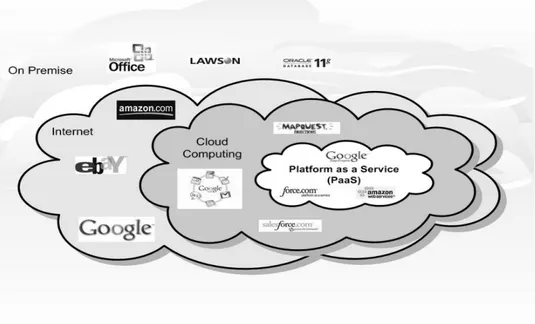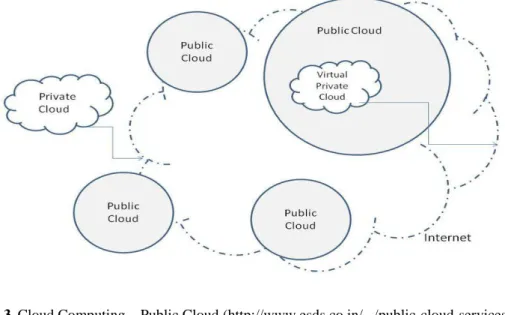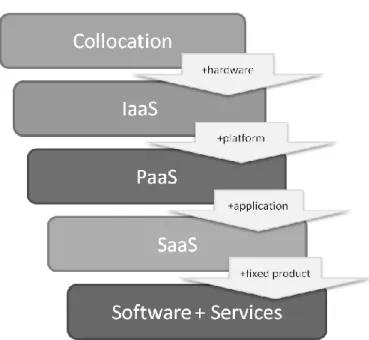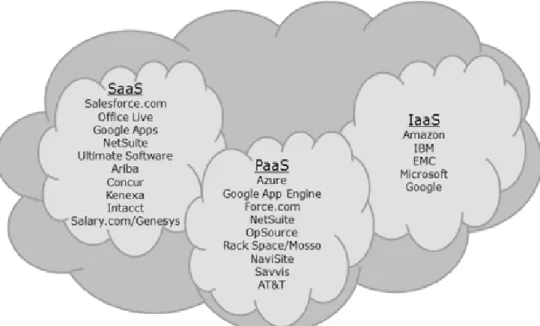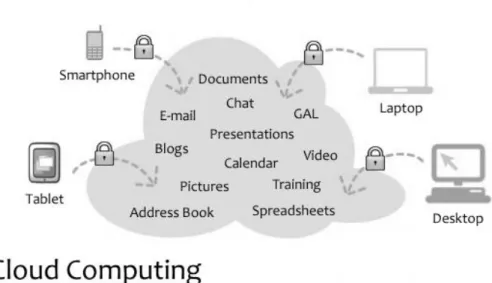CLOUD COMPUTING – THE BENEFITS AND RISKS
Małgorzata Woińska* and Maciej Kołtuński**
* Faculty of Engineering Management, Poznan University of Technology, Strzelecka 11, 60-965 Poznan, Poland, Email: malgorzata.woinska@wp.pl
** Atos Origin IT Services sp. z o. o., Poland
Abstract More and more frequently companies decide to get rid of certain functions of their structures by using outside firms to provide components and services. Outsourcing, very popular in recent years, has the purpose of reducing spendings in departments of a company. However, it this goal achieved? Often, such cost reduction is connected with the dependence of the customer on the supplier - which can, in the long run, globally contribute to raising costs. Will such delegation of certain responsibilities not cause a significant danger of losing its independence and a gradual increase in spendings in such a way that, in a broader perspective, they will be much higher than the costs before outsourcing? What will happen when a company dependent on its supplier or provider wants to pass another or a different company a particular job? Furthermore, if the company management decided to dispense with the services offered by a third party - would we be able to import the data that we receive into any other system?
The compilation is an attempt at familiarizing the reader with the meaning of Cloud computing, as well as the concepts directly related to it. An attempt has been made to systemise the knowledge of the subject and present the main premises and hazards that are associated with the implementation of solution.
Paper type: Literature review Published online: 19 July 2011 ISSN 2083-4942 (Print) ISSN 2083-4950 (Online)
© 2011 Poznan University of Technology. All rights reserved. Keywords: Outsourcing, public cloud, private cloud, virtualization
1. INTRODUCTION
We live in a time when technological progress takes place each day. Even those directly interested in test results, it is hard to keep up with changes. We use tools and equipment that a few – a dozen years ago were completely unimaginable. New technologies have enabled the rapid communication of enterprises from different parts of the world. Contributed to the global village, to streamline many processes.
New solutions offer tremendous opportunities for growth, but also pose a serious threat. How much we are dependent on technology, we can notice when we see crashes such as the mail server or software, which is based on company performance.
For several years, we observe a progressive tendency to output increasing number of functions beyond the company, which aims to reduce the cost of business. Outsourcing of jobs to outside companies involved in maintaining order and security on the agenda, companies too often forgot the purchase of equipment and infrastructure maintenance for the lease. The consequence of the prevailing trend in the market is also discouraged companies from creating their own infrastructure for virtual solutions. This solution, however, raises serious concerns.
2. WHAT CLOUD COMPUTING IS EXACTLY?
Despite the constantly grooving popularity the concept of cloud computing isnot
clearly defined in the literature of the subject, as a result of which it is not understood well. Such situation leads to confusion and misinterpretation of the importance of the issue. Even the representatives of the service providers of the Cloud model find it difficult to define what Cloud computing precisely is. The concept has become a trendy marketing phrase – a skeleton key that is widely used but understood by few. The lack of a clear definition means that within the same notion different suppliers provide tools of quite different functionalities. In its essence, cloud computing is a form of outsourcing – it can be said that it is more tailored and geared towards customers‟ needs.
Fig. 1 Public cloud - own work based on (Rzewuski, 2009)
The figure above presents the different perceptions of public services in the cloud between the supplier and customer. Such a multitude of available options can be exceptionally problematic for many managers. The person managing IT resources must have the knowledge or the right team of skilled professionals. Only in this way will she find out all the pros and cons of a solution. Possessing such knowledge by the person responsible for decision making will be familiar with the conditions and premises, which will enable them to select the most suitable and desired option for their business.
'The biggest challenge and, at the same time, constraint which very often stand in the way of virtualisation is the necessity of carrying out an organisational change. The dissemination of the technology can change completely the relationship between IT and business departments (Pietrzak, 2010). „ Under the notion of virtualisation
itshould be understood as a replacement of conventional physical servers with virtual devices - on servers located in one specific location.
With access to a growing power of standard servers, companies use virtual solutions more and more frequently. A fully scalable environment is obtained – which means that the whole unused power generated by one or more physical machines can be fairly easily directed in virtual environment to such a server which needs it at a given time. In the absence of such requirements the resources are automatically transferred to other units. Unused power, or capacity in other words, which is obtained can be allocated to and by adding additional virtual machines with new functionality without the necessity of supplying additional further physical machines. The increase of computing power for the most demanding applications is significant.
This principle has been used by Internet Service Providers for years (ISPs). With a link of 100GB capacity there is never a situation of its being used 100%. The average link utilisation does not exceed 50% even at peak hours. It happens so because each customer using the Internet on average for about 4 hours daily uses up approximately 30-60 minutes of its speed. Throughout the remaining time the link is not so overloaded. In such case, form the point of view of the Internet Service Provider there are no obstacles to increase the number of customers on a given link.
In order to make the optimal use of the possibilities that virtualisation offers the entire environment should be centralised. By the concept of centralisation is meant focusing certain functionalities and systems, e.g. mail server, within one infrastructure location. The concept can be explained be the following example. A company with branches in several cities in the country or abroad has separate mail servers in each location. However, it generates additional costs, such as the purchase of software licences, costs of infrastructure maintenance and servicing. In case of transferring the IT infrastructure to a single location the number of licences and mail servers is reduced.
Fewer licenses means real savings, yet, this approach poses high risk when a failure occurs. After migrating mail servers in a failure, we are at risk of a complete lack of access to mail servers in the whole organisation – it will apply to all locations. Therefore, in the case of centralisation it is raising the level of service that is of key task. It can be achieved by reducing, in the event of failure, the repair time of service to a minimum. The service agreement of 24/7/365 service availability, where the fault removal time is up to 4 hours, can be used. This will ensure that the company's employees have a continuity of access to e-mail
ata relatively low cost of increasing the level of service.
In the case of centralisation one of the priorities is making backup copies, which directly protects a company against the loss of its key data.
The sentence often repeated by administrators, namely “The data are lost forever - it's just a matter of time is frequently underestimated. If we do not store personal data we put ourselves at risk of losing it, often irreversibly. As far as centralised computing environments are concerned the issue is particularly important. There is not any part of the data in other locations, for which reason it can not be recovered in any way. The subject and problem of data loss is so ungrateful because it does not occur every day while people perform their duties but comes up when something really goes wrong. In the context of Cloud computing the problem still exists and, what is more important, it can escape our attention. A company in which the infrastructure is located will not on it its own initiative be carrying out, for its clients, activities connected with protecting and archiving the data in case of loss. The client, having no physical access to the infrastructure, will not be able to deal with it themselves. Therefore, it is worth remembering to include a point concerning settling the issue of making a backup copies during signing the contract. In addition, the problem related to the duty of
keeping backups in different locations is disregarded. As an extra precaution, for example a backup ought to be exported to the deposit every other day.
2.1. Types of Clouds
In the literature, the concept of Cloud Computing can be seen in several aspects. There are three basic types of clouds. The first group contains solutions that can be classified as private clouds (called Private Cloud). They are a part of the organization at the same time being an autonomous stand-alone service provider. This type of solutions is geared towards large enterprises. In the variant, the IT department provides infrastructure within the limits of Private Cloud as well as applications in the form of services within its corporation. Examples of solutions in the private cloud are shown below.
Fig. 2 Private Cloud for home users (http://kaylakunz.com/.../private_cloud.png)
The second type includes public clouds (called Public Cloud). These are external publicly accessible provider (such as Amazon.com, Google, Microsoft, etc.). This form of solution may be attractive to small and medium enterprises. Companies which chose to implement such a solution would not have to maintain their own expensive and often complex infrastructure, as well as personnel, who is necessary for their operation. Also, the flexibility and availability of information
systems would improve and increase. In this way, companies can buy ready-made applications without requiring a separate purchase of hardware and software.
Fig. 3 Cloud Computing – Public Cloud (http://www.esds.co.in/.../public-cloud-services)
On the one hand public clouds offer many benefits, but the other hand they present the greatest challenges of security and privacy. Private clouds had 64% response versus 30% of public clouds (http://www.esds.co.in/.../public-cloud-services).
The Biannual Evans Cloud Development survey 2010 consisted of greater than 400 software developers out of which 40 % of them voted Google as the best public Cloud provider. And 30 % of them voted for IBM to be the best private Cloud leader (http://www.itechfreak.com/.../top-2-cloud-providers-google-and-ibm/).
The third category consists of hybrid clouds (called Hybrid Cloud). They are a combination of the philosophy of private and public clouds. A certain part of the application and infrastructure operate in the client's private cloud while the other part is located in the space of a public cloud.
The Cloud computing Phenomenon can be presented with an example of spreadsheet. The customer pays for the ability to create sheets, yet, they are neither aware of where the software is physically installed nor on what hardware nor where their data is stored. There is also no need to know what other services are used to provide the service that the customer is directly interested in. Cloud is a virtual cloud of services available for the client. All the details are hidden in it, the awareness of which is not necessary for using the service.
More generally, the typology can be made into a more detailed one according to type/models of cloud computing.
2.2. Systematics of term
Cloud computing can be perceived and considered on various planes. It can be used in various combinations and ranges – depending on the type, size, and needs.
Fig. 4 Services in the Cloud Computing for a Business (http://blogs.technet.com/.../co-jest-chmura-cloud-computing.aspx)
The oldest and the simplest form of service in the cloud is a Collocation. It requires renting a server space, electricity, air conditioning and access to the Internet. The company that uses it pays for the remaining components – hardware, security (firewall), load management, operating system, software and applications. It is therefore a fee for lending the space in the server room.
IaaS – Infrastructure as a Service is a model that is to provide IT infrastructure,
i.e. hardware, software, and service to the customer. For example, the customer buys a certain amount of servers, disk space or an amount of resource memory and computing power. It does not mean that the equipment will be physically installed on the customer's premises. In this model, it happens so that the customer provides their own software to the provider in order to be installed to the rented equipment. In this variant, the parameters such as bandwidth and connection availability are under constant control, the aim of which is protecting the client against the lack of availability of network resources, hackers and the lack of efficiency of operating systems. The initial solution of IaaS type was hiring, from the providers, dedicated server services, that is, the ones allocated for the needs of one specific customer or task. Currently, as a result of virtualization
the machines take the form of virtual machines. In the former variant (dedicated server) the client pays for the equipment as a box set (in terms of a machine). In the newer variant (virtual machine) the customer pays for the power that the servers have actually used. As an example we can cite the following scenario. A company has a peak demand of 500 servers, but the average consumption amounts to a usage of 300 servers. The cost per day is 300 x 24 or 7200 servers per hour. But the company sets its data center to the peak load and pays 500 x 24 or 12,000 servers per hour. It is a factor 1.7 higher than necessary. In the model pay-as-you-go you pay for what you actually use and so, if the TCO is less than 1.7 times the cost of purchasing and maintaining servers, it is beneficial to use a public Cloud (http://www.itechfreak.com/.../-2-cloud-providers-google-and-ibm/).
PaaS – Platform as a Service – is a sale of a complete application. It is often
adjusted to the needs of an individual. The solution does not require a purchase of hardware or a software installation. All the necessary programs are located on the supplier's servers. The customer, on their side, has got access to the interface (usually in the form of a unified work environment) through the program – the client, e.g. a web browser. In this model, most services are accessed from any computer that is connected to the Internet. In this variant, the service provider secures the availability of a platform to a certain number of users, thus, ensures its security and stability. The recipient pays for certain definite resources used – CPU time, the used place, the number of translations or transfer. It is usually done periodically, once a month most frequently. In the case of the virtual server fixed fees are usually paid yearly. The fee is fixed regardless of how the customer uses the server. The amount of money, the fee, possibly depends on the amount of disk space or complementary transfer.
The Platform as a Service model is designed mainly for large systems that require a significant customization or adaptation to the customer's the individual needs of. In this option not only the solution is purchased but also a platform on which it will work. What is given outside is the data and customization of the systems. While the entire system, infrastructure and IT department remain in the structures of the company.
Simply put, the mobile communication can be used as an example. One can pay for the subscription and be charged per minute and have an offer that is averaged (which sometimes the customer is not able to use up). One can also choose a pre-paid offer and pay according to their needs, be charged for seconds and use an offer geared towards their own needs (the customer knows the offer exactly and pays for what they use) and, in addition, the customer may terminate the contract at any time without the necessity of waiting for example 2 years until it expires).
SaaS – Software as a Service. In this variant the customer receives specific
functionality and software – the ones that they need. They use such software as they need. They are not interested in the equipment or work environment. They have only got access to specific functional tools - not necessarily interconnected with a single interface. The programs operate on the supplier's
server. The customer is not obliged to purchase the license to use the programs. The customer pays for every time they use them and receives access to the programs on request. To sum up, the client actually uses only one application and its functionality, that is, they buys a ready-made solution – a system with an application. The customer does not install such application on their computer at home but only uses it in the cloud via the Internet.
In such case, customers are most often charged in a model – a fee per user for one month of using the application. The drawback of such a solution is the fact that we can not introduce changes in the application; nor do we have any bearing on its development (at least not decisive)
The Software as a Service model is based on the use of shared applications over the Internet. In this case it is only the solution that is purchased. It is the most popular form of clouds. The data center technical team constantly ensues safety and continuity of application operation, which constantly responds to the customers' notifications about failures, errors or problems. At the same time, the system diagnostics and reporting is run.
The figure below present the leading service providers in the cloud model and examples of solutions.
Fig. 5 What is a cloud – the concept taxonomy (http://www.itechfreak.com/.../-2-cloud-providers-google-and-ibm/)
CaaS – Communications as a service. In this case, the service provider provides
a platform for telecommunication work environment. CaaS is designed for administration, configuration as well as billing, centralizing the use management, for hosting personal management and an application for making phone calls automatically. In the offered solutions the following may be available: functions of automatically distributed call, monitoring and call recording, menu access, IVR, call management and agents' availability as well as conferences and chats.
The solution is most often designed for contact centers and enterprises regardless of size as well as for companies employing remote and mobile workers.
Nowadays, more and more new features are placed in the cloud computing model. Reaching the peak of virtualization is just a matter of time – the transfer of all software (including the operating system) to the server, and on the customer side the installation of 'thin client' possessing only interfaces to communicate with the person who supports or serves them. The 'thin client' is a computer or a specialized device (a computer terminal) with the appropriate client-type software, enabling the service of an application created in a client-server architecture. That kind of solution is illustrated below.
Fig. 6 Cloud Computing – Microsoft‟s vision (http://wapedia.mobi/en/Cloud_computing)
A special feature of thin client is the independence from the attended server application (its change does not entail the necessity of replacing the client's
software). The additional advantage is the low demand for processing power (http://www.ibm.com/.../l-thin-client-cloud/). 'With high-speed Internet connections it could connect to the server that does not belong to the local network but to a one which is located anywhere in the world. This contributes to additional extra functionality of SaaS (Software as a Service) – DaaS (Desktop as a Service). In the model the user would buy, from the provider, a hosted virtual machine which would be fully personalized and with the specification as one precisely needs or expects.
3. ERP IN THE CLOUD
What is increasingly gaining on popularity is solutions which enable the use of the advanced capabilities of integrated ERP management systems form mobile devises. Changes in this area seek to introduce the possibility of free use of this type of software regardless of the device that the customer uses. It is the methodology of implementation that undergo changes. The introduction of self-service and a far-reaching simplification of implementation processes are aimed at. In Poland, however, the cloud computing solutions type for applications such as ERP still encounter a mental barrier. It is directly connected with the fact that companies are afraid of losing their data. These concerns seem most appropriate. The ERP type applications serve, support and include the key data for the enterprises. They contain the financial-accounting information concerning sales volumes, the levels of discounts and payment terms as well as all the information strictly related to the range or scope of logistic functioning in the enterprise, including suppliers' databases, the purchase prices, the delivery time, the payment terms and information concerning the production planning. Such type of information constitutes one of the most guarded, protected and secret type of data because it accounts for the competitive advantage and profitability of an enterprise. The data mentioned above, if it got into the wrong hands, could condition the existence of an enterprise. On several occasions the news reached the public about hacker attacks on the database of the leading global marks or brands, which resulted in such leakage of customers' database (hacker attacks on the SONY database).
The fear of delegating, from the point of view of an enterprise, applications to outsourcing, therefore, seems justified. The data is placed on servers in an unknown location to the client. The opportunity of such a cost reduction is connected with a chance of losing the control over the data. Data loss, in this case, can mean the end of the business.
4. CLOUD A THREAT
“Cloud Computing model differs significantly from the model which has been used in computer science until now – namely the purchase and exploitation of infrastructure and software (licenses). (...) The problem lies in the answer to the following questions – where exactly is the data located, who owns it and how is it secured or protected. While the first problem is somewhat contrived because what do we gain out of the fact that we have the data on our own drives if, as a result of the use of closed solutions, we can not access them, the second and third are very real. A company which entrusts the processing of their own important data (such as sales, customer base, customers or suppliers or financial data) almost always underestimates the risk connected with it. Contrary to appearances, or, what it looks like, it is not just a matter of contract provisions, but also of the entire infrastructure and the support processes, and, consequently, of a real control over the sources of their competitive advantage.
In order to provide the 'cloud processing' service huge capital resources are needed: to build a data center, to invest in the links, safety and security, access channels, etc. Only big IT vendors can afford it. They displace small and medium-sized companies from the market. Furthermore, with a colossal advantage of force, resources and knowledge over their customers / competitors, they are capable of imposing standard conditions (which are beneficial to the them, that is, to the big IT vendors). In such a situation, not only does our dependence on the supplier increases but also it is a supplier with whom we have little chance in the event of a conflict or a clash. The cloud, de facto, shifts our company into an entirely new dimension of dependence on technology and the supplier. Will the availability or, in other words, the accessibility, the price and a change of the model of financing reward our problems? Every manager must answer this question themselves” (own work based on) (Chabik, 2010).
5. CONCLUSION
The decision concerning which functions can be transferred away form a company must be preceded by a thorough analysis. What can be delegated outside first is the applications that are not, from the point of view of the organization, the critical applications, i.e. those which do not determine the company's competitive advantage over other organizations but are tasks that must carried out or handled. The delegation of a certain part of functionalities away form the core business activity of an enterprise can be perceived as a threat to the IT staff, who, at this point, can be perceived as useless. Such actions do not have to necessitate a job reduction. Relieving workers of certain functions that are to be outsourced creates the possibility for focusing more effectively
on the strategic functions form the business perspective, the perspective of the company's progress and prosperity.
At the same time it is difficult to clearly define which functions or features can decidedly be moved to the cloud. It is directly conditioned, or, in other terms, dependent on the type of an organization in question. In each company, due to the nature of activities and the data security policy the functions in question will be entirely different and even if the functions converge or coincide with one another the range in which they are to be moved will differ.
REFERENCES
Chabik J., (2010), Z dużej chmury zimny deszcz, available at: http://www.computerworld.pl (accessed 03 May 2011).
Cloud Computing – The Complete Cornerstone Guide to Cloud Computing Best Practices, (2010), The Art of Service, e-book from http://theartofservice.com/ (accessed 13 June 2011). Computer World, date 13.10.2009, No. 37/871.
Holme D., (2008), Resource Kit: Productivity Solutions for IT Professionals, Microsoft Press a Division of Microsoft Corporation One Microsoft Way Redmond, Washington 98052-6399, USA.
http://blogs.technet.com/b/mkedziora/archive/2010/05/08/co-jest-chmura-cloud-computing.aspx (accessed 13 June 2011)
http://blogs.technet.com/b/mkedziora/archive/2010/11/06/r-243-ne-chmury-publiczne-prywatne-dedykowane.aspx (accessed 13 June 2011)
http://kaylakunz.com/images/private_cloud.png (accessed 13 June 2011) http://wapedia.mobi/en/Cloud_computing (accessed 20 June 2011)
http://www.esds.co.in/blog/while-using-public-cloud-services (accessed 13 June 2011) http://www.ibm.com/developerworks/linux/thin-client-cloud/ (accessed 14 June 2011) http://www.itechfreak.com/latest-technology-news/top-2-cloud-providers-google-and-ibm/ Johanson J. M., (2008), Windows Server 2008 Security Resource Kit, Microsoft Press
a Division of Microsoft Corporation One Microsoft Way Redmond, Washington 98052-6399, USA.
Pietrzak P., (2010), "Chief Technologist Busines Analytics & Optimization w IBM", [in:] ComputerWorld, No.45/913, date 07.12.2010.
Rzewuski M., (2009), "IT w chmurze", [in:] Computer World, No. 37/871, date 13.10.2009, p. 15.
BIOGRAPHICAL NOTES
Małgorzata Woińska is currently a PhD student of the Faculty of Engineering
Management at Poznan University of Technology. She has several years of practical experience of working within international logistics companies. Her scope of scientific interests include the wider issues related to logistic supply and the optimization of flows in the supply chains. Her publications include the field of progress optimization of supply.
Maciej Kołtuński, a graduate of Poznan University of Technology. Over the last
4 years he has been responsible for maintaining the IT infrastructure in one of the factories of the chemical company Akzo Nobel. He is currently administering servers in a virtualized environment for an international Customer of the banking sector, with particular regard to security reasons.
